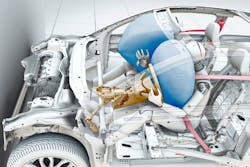Automatic Emergency Braking Market to See Growth
March 1, 2017—A report by Global Market Insights said the automatic emergency braking (AEB) market size is poised to surpass $15 billion by 2024. Worldwide installations are forecast to hit 45 million units by 2024.
Growing awareness about vehicle safety among customers and manufacturers will drive the AEB market, the report said. Governments and other organizations are actively involved in introducing and mandating the utilization of these technologies in vehicles. Rear-end collisions that occur due to tailgating are the most common types of accidents. The U.S. National Highway Traffic Safety Administration (NHTSA) reports that rear-end collisions represent one-third of the vehicle crashes. While few accidents cause human losses, some involve major injuries and property damages.
Because safety ratings greatly affect American buying habits, said Andrew Miller, chief technical officer for Thatcham Research, U.S. collision repair professionals can expect features such as AEB to soon become standard. The technical challenges associated with those repairs become more prominent and necessary to understand, particularly because AEB sensors require recalibration.
The European Commission has adopted road safety programs aimed at reducing road deaths in Europe between 2011 and 2020. These programs set various initiatives focusing on improving vehicle safety, infrastructure, and road user behavior. From 2014, Euro NCAP—which Thatcham joined in 2004—mandated vehicles in the EU were to be equipped with active safety systems, which avoid or mitigate collisions with low and intermediate speed to achieve a 5-star rating. This assessment particularly focused on the quality aspect of how well driver assistance systems perform in a given test scenario.
AEB market adoption depends upon the nature of the road conditions, the report states. Real-time up-to-date information is a critical element of the system, which includes information about dynamic road conditions, intended action of other vehicles, and environmental or road infrastructure. The economic factors associated with the AEB market growth include decreasing the severity of accidents, which reduces the vehicle damage and reduces insurance claims. Moreover, insurance companies are also lowering their premiums.
The willingness to adopt these systems among consumers is high in developing countries, but the price and infrastructure required for this technology are restricting the adoption, said the report. Companies succeeding in providing cost-effective and need-specific features are likely to get economic benefits and brand differentiation.
Some AEB market participants are Bosch, Autoliv, Mobileye, Continental, and ZF-TRW. Frequent mergers and acquisitions along with collaborations are among the major trends. For instance, Bosch in collaboration with Land Rover has developed stereo vision camera, which can operate AEB stand-alone with no extra sensors. It eliminates the use of radar combination and video sensors.
